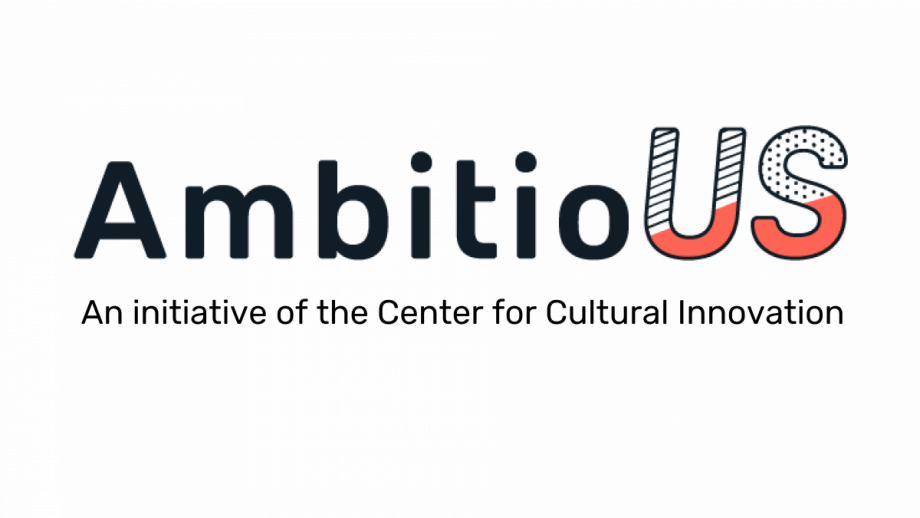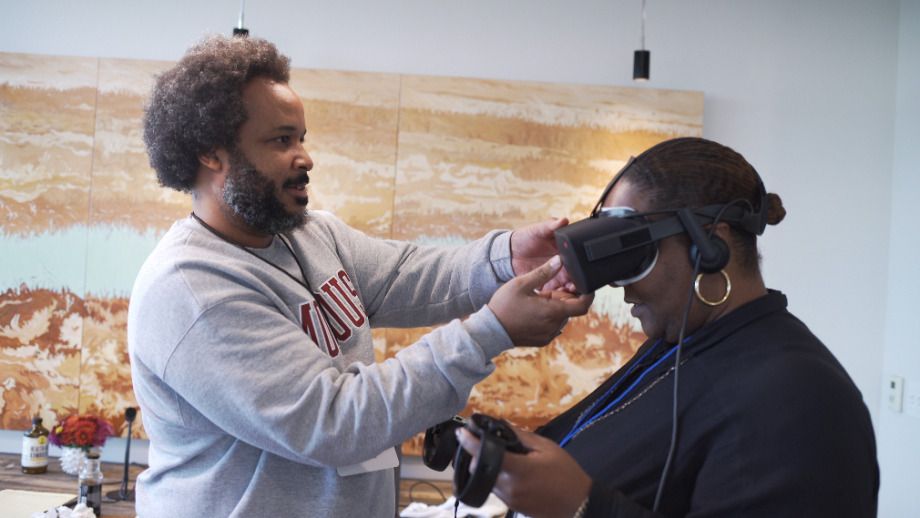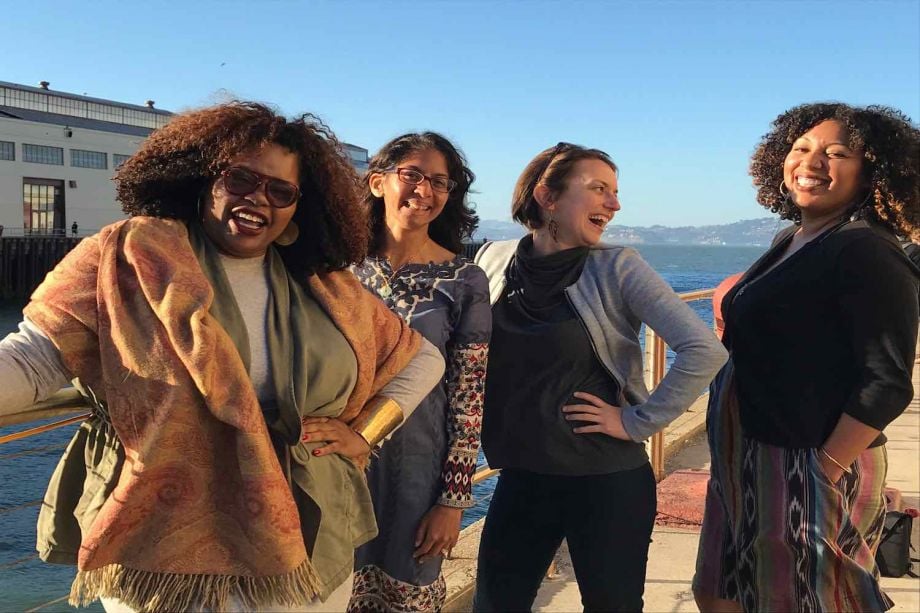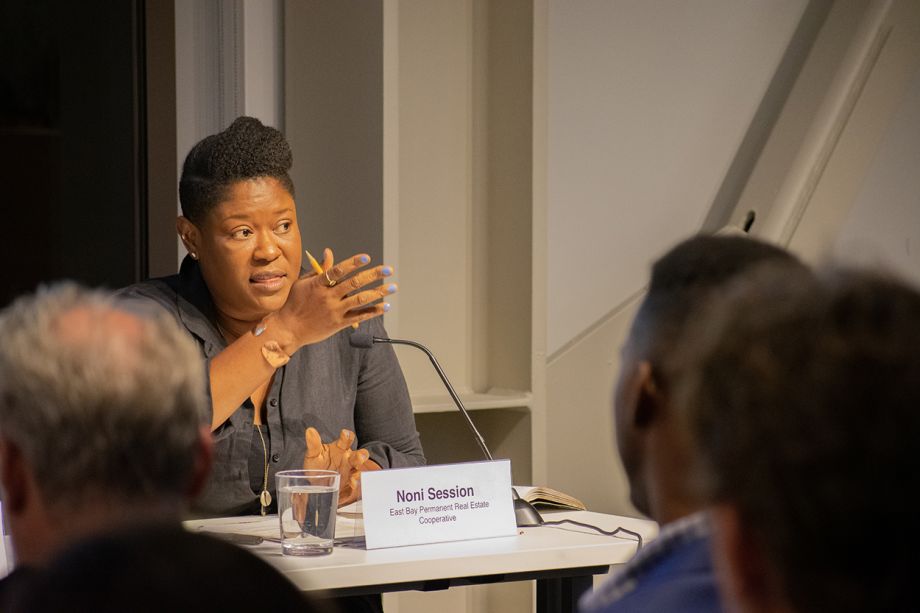Are You A Vanguard? Applications Now Open
Zebras Unite founders (left to right) Mara Zepeda, Aniyia Williams, Astrid Scholz and Jennifer Brandel.
Photo by Adrian Hallauer/NY Times; courtesy Zebras Unite
EDITOR’S NOTE: This sponsored content is paid for by the Center for Cultural Innovation (CCI). CCI is also a funder for Next City editorial content. Read stories they have underwritten in a series called The Creative Economy, which explores how alternative economic models can empower artists and culture bearers.
Ask nearly any artist or freelance worker and they’ll tell you: the current economic paradigm — profit at all costs — isn’t working. While a few at the top of the ladder are getting increasingly wealthy, many are facing increasing displacement, economic instability and disenfranchisement.
AmbitioUS is proving to be a catalyst to change that. Launched earlier this year by the Center for Cultural Innovation and the backing of justice-oriented foundations, the group is investing heavily in entities developing new economic systems that benefit the collective, rather than just a few at the top. And they have begun with a population particularly vulnerable to economic downturns: artists.
Artists have long been at the forefront of shaping alternative economic paradigms. Dating back to the medieval guilds of Europe, artists worked together in cooperatives to meet their common needs. The contemporary word “gig” — now used to capture those driving Uber or finding short-term jobs on freelancing websites — grew out of the 1920s jazz scene, where artists would use the term to refer to the musical assignments they strung together to get by. Without artists inventing ways to survive outside the safety net of salaried positions, we wouldn’t have the culture that is the heartbeat of our communities. Likewise, systems where artists can thrive and where culture is supported are systems that have the potential to work for us all.

“Artists have always worked outside conventional structures of support, but as more wealth has concentrated at the top, more-and-more people find themselves living like artists,” says Angie Kim, the president and CEO of AmbitioUS. “Moreover, even conventional systems that used to work for artists have not kept pace with the rising costs of living. We launched AmbitioUS as a time-limited initiative to create urgency that now is the opportune time to make significant investments in shaping what the next 25 years will look like. Even though our funding cuts across all sectors of the future of work, community development, and the environment, artists and cultural work are the right north star because focusing on their financial conditions and opportunities ensure our support is about enabling people and their ideas to come to life.”
The initiative launched in early 2019. Below, meet the first class of grantees and investees.
In 2016, more than a century after the film industry was born, all 20 actors nominated for Oscars in the lead and supporting acting categories were white, sparking a backlash that led to #OscarsSoWhite trending on Twitter. While 2018 and 2019 proved slightly more diverse, in the Academy’s 89-year history, there have only been 16 black Oscar winners in these categories.
Lauren Olivia Ruffin wants to ensure that 50 years from now we’re not dealing with #VRSoWhite in the extended reality space.
“This very new industry is evolving much the same way as the film industry and the gaming industry developed,” Ruffin says. “And both of those industries are structured from a very hierarchical perspective that has white guys at the top, and others can only get their stories out in the world by selling their intellectual property to these white-led organizations.”
Ruffin is the co-founder of Crux, a new studio completely led and owned by black people that supports extended reality (XR) content creation from black artists, from training to distribution (the other co-founder, Dafina McMillan, has transitioned out of her day-to-day role at Crux). XR includes all real-and-virtual combined environments, including augmented reality (AR), mixed reality (MR), and virtual reality (VR). As a still very new industry, XR has the potential to be less plagued by a lack of diversity, as long as the right people can get in on the ground floor.
XR creators aren’t immune to the funding struggles most artists face. A 2017 study from research and development firm Helicon found that despite efforts by many leading foundations, arts funding has become less equitable, not more, in recent years, with just 2 percent of all cultural institutions receiving nearly 60 percent of all contributed revenue. However, Ruffin sees an opportunity for more diverse communities to become captains of a very new industry.
“Whenever we have a solid understanding of what’s happening in these new fields, we’ll be able to take advantage of it,” Ruffin says. “Ultimately, we can’t continue to let large studios take away our creative property. We have to organize better to maintain our culture and our assets.”
So far, Crux takes many forms: a platform-based collective of artists; a content studio; a consultation firm for black XR artists looking for help creating, promoting or distributing their work; the host of an “unconference” for black visual artists, theater-makers, filmmakers, and technologists; and, as of last month, an app that connects artists with people seeking XR content.

An XR experience from the inaugural Crux unconference. (Photo courtesy CRUX)
After using philanthropy to get off the ground, they’re now weaning themselves off that model by rolling out a cooperative organization with support from AmbitioUS. The co-op is aimed at filling in the friends-and-family capital gap for black artists by pooling resources to finance new projects by its members, but will also help them organize their capital in a way that isn’t predicated on one person, or a group of people, benefitting from everyone else’s labor.
“Investors have decided they’re going to invest in one model,” Ruffin says. “It’s much more interesting and creative to figure out what is the best vehicle for the particular type of work so that everyone can profit. So many of us are operating on models based on the military and Catholic church — it’s completely insane for us to continue to build businesses that way.”
After Hurricane Katrina, nearly every system failed the residents of Prichard, Alabama. The political system broke down, the nonprofit system left many behind and schools were quickly privatized. The people who were able to get back on their feet all had something in common — money and resources, or connections to people with money and resources.
“We couldn’t all be in the same bad spot together to help people out,” says Jessica Norwood, a Prichard native. “Someone in your network had to be able to help out.”
Prichard was founded after the Civil War by people who were brought to Mobile, Alabama, on the last known slave ship to the U.S. Even before Katrina, many local businesses struggled if the founders didn’t have connections, particularly as more profitable parts of the city were annexed into Mobile.
“I was seeing that [struggle] growing up and wondering to myself, how can we do this differently?” Norwood says. “How can we help people who have these incredible skills, cultural narratives and stories really thrive?”

Members of the Runway Project, from left to right: Jessica Norwood, Rani Langer-Croager, Annie McShiras, Nina Robinson. (Photo by Amy Cortes; Courtesy The Runway Project)
Her childhood experiences eventually led Norwood to start the Runway Project in Oakland, a funder for black-owned businesses that fills in the friends-and-family capital gap many black entrepreneurs face. Pew Research Center has found that the median net worth of white families in the U.S. is $142,000, compared with a median net worth of only $11,000 for African-American families. This leaves black-owned startups at a significant disadvantage. The Runway Project reimagines how businesses get the start-up capital they need, regardless of their connections.
For starters, the Runway Project doesn’t ask borrowers for collateral. The racial wealth gap means black entrepreneurs are less likely to have the necessary collateral to get a loan, so the Runway Project puts it up. The Runway Project also has a community underwriting process. In each community where they’re making loans, local business owners and workers are part of the decision-making process for who gets loans, allowing them to help determine the future of their business community. Importantly, anyone can be an investor, including large givers like the Ford Foundation and individuals giving small amounts to help their community grow — including Norwood’s dad.
Each five-year loan is modeled off friends-and-family money, meaning it has a low interest rate (the first two years are interest-only payments set at 4 percent) and comes with technical and business support from their partner Uptima Business Bootcamp for the entire life of the loan, including peer-to-peer coaching.
“It’s not just about getting the capital, but keeping the capital and making it work,” Norwood says.
AmbitioUS helped Runway Project with their own need for runway capital, and they’re now working to implement the model in several other states. The result has been loans for a diverse set of ambitious, social-minded businesses, including many creative and cultural companies.
“There’s a cultural retention with the artisans,” Norwood says. “They’re able to keep those traditions infused in the community.”
In the case of Something Better Foods, a vegan food company, Runway Project funding enabled founder GW Chew to hire another person so he would have the time to pursue opportunities to grow his businesses. His products are now in 400 Whole Foods stores.
“That little bit of money can be very powerful in getting a business to the next level,” Norwood says.
The last few years have seen many of Silicon Valley’s darlings fall, whether financially, like WeWork, or by coming under political fire, like Uber. Facebook, one of the country’s most dominant startups, was even weaponized to spread fake news during the presidential election. Instead of shifting their focus, however, venture capitalists remain obsessed with what’s called “unicorns” — privately held startups valued at more than $1 billion.
These “unicorn” companies tend to be bent on “disrupting” industries such as transportation and housing, rather than supporting businesses focused on the wellness of the community. They’re also typically led by people who look like the funders themselves: white and male. Only 3 percent of venture funding goes to women and less than one percent to people of color. The system simply isn’t working for most would-be business owners.
Enter Zebras Unite, a movement and network that connects founders, investors and communities who want to see a more sustainable and inclusive kind of startup ecosystem, including cultivating capital that is the opposite of extractive and that would enable founders to retain ownership. Unlike unicorns, many “zebra” businesses straddle the line of being for-profit companies and having a purpose; some are structured to generate wealth for more than their founders and investors — such as through worker or customer cooperatives — so they don’t fit the typical venture capital profile. Others want to generate wealth for founders and set social-impact goals — and investors are usually less interested in the latter. Co-founder and Treasurer Astrid Scholz, who is also the founder and managing partner of her own company, Sphaera, says VC firms are missing a big opportunity by overlooking these types of businesses.
“They’re all looking for unicorns, but they wouldn’t recognize a black swan if it bit them in the face,” Scholz says. “Women and people of color and veterans and young people who are crushed by student debt are using business to solve something that they’re experiencing in their life, and just the sheer force of demographics suggest that these are potentially very lucrative, very large industries. And so we need to invent the kind of capital that is suitable for those new businesses being invented right, left, and center.”
The movement has members ranging from Silicon Valley to Scotland and includes an online community where members learn from each other through discussions and webinars as well as in-person programming led by the 40-plus local chapters based on six continents. In 2017, Zebra’s unite also held its first DazzleCon gathering (a group of zebras is called a dazzle). They’ll hold a second gathering called DazzleCamp in May 2020.
“We very much think of Zebras Unite as almost like a global Chamber of Commerce, if you will, for these new kinds of businesses,” Scholz says. “We would really like to see entrepreneurs of all different stripes find each other and find the capital that they need to grow their businesses, and not feel so alone or like they have to turn themselves or their businesses into something they’re not.”
Zebras Unite is building a new community of entrepreneurs and investors who want to make a difference and not just become rich at others’ expense.
When third-generation Oakland native Noni Session moved back home in 2011, she saw a different city than the one she had left in 2001 to get her doctorate at Cornell. Tents lined the streets, and encampments had popped up across the city.
Her first assumption was that they were filled with nomads or those struggling with addiction, but she later learned that 60 percent of people sleeping outdoors were working Oaklanders who were pushed out of their homes and had nowhere to go.
Between 2006 and 2011, 10,508 homes — more than 7 percent of the city’s households — were foreclosed and repossessed. These bank-owned homes were concentrated in West and East Oakland, and most were occupied by people of color — and had been for generations.

Noni Session, executive director of the East Bay Permanent Real Estate Cooperative (EB PREC). (Photo courtesy EB PREC)
“For many black Americans, they have nowhere else to go,” Session says. They have no country to return to. So when they get pushed out of their homes, they sleep on the street in front of their homes and then get up and go to work.”
Today, as the executive director of the East Bay Permanent Real Estate Cooperative (EB PREC), Session is helping Oaklanders gain homeownership and reverse the power dynamics of landlord and tenant using collective action.
“To build a healthy, strong, vital community, folks need ownership,” Session says. “They need to know they belong there. They need to be able to envision a long future in that place.”
So far, EB PREC has three community-owned properties that provide affordable housing to resident-owners who build equity in the home with each payment. There are no renters — one of the pillars of EB PREC is “land without landlords.” They’re developing a legal tool that reserves land for justice based use so any owner now or in the future is not able to charge extractive rents or sell the land for speculative profit. Their platform is also deeply political; they are working to take back control of their neighborhoods from City Hall and show that property can no longer be used as a tool to oppress people of color.
“We have chosen to bake into the DNA of EB PREC, whether it be radical or not, that this is an organization that is meant to be locally and black- and indigenous-led to prioritize the needs, aesthetics and vision of those communities,” she says.
All of their efforts, including their system for fostering affordable homeownership through a cooperative model, are being shared as open-source tools so that other communities facing displacement can replicate their proven techniques.
Beyond providing economic stability for black and indigenous communities, Session says land ownership is essential to preserving culture.
“When culture is just floating out in the air, that’s when you get a people with confused identity,” Session says. “You move grandma to Antioch, you move niece to Georgia, you move cousin to Wisconsin, and then there’s nowhere to come to dip into the oral history, the aesthetic history, the written history.”
AmbitioUS’s funding is being used to subsidize Oaklanders’ investments and membership dues so that they have an ownership in EB PREC’s real estate ventures.
Boston Impact Initiative
A community-based impact investing fund, the Boston Impact Initiative focuses on economic justice in communities of color in Eastern Massachusetts by investing in local businesses that are either owned by or serve people of color. With the help of AmbitioUS, BII is taking its approach nationwide by training a national cohort of community leaders to develop funds in their own communities.
Boston Ujima Project
Focused on building a community-controlled economy for African Americans in three Boston neighborhoods, the Boston Ujima Project (BJP) is a democratically governed investment fund controlled by the neighborhood residents it is set up to serve. AmbitioUS’s purchased investment notes that position Center for Cultural Innovation to be the first to take a loss if loans are not paid back (not the borrower and their assets nor the communities).
Common Future/CoCap
AmbitioUS, Common Future (formerly known as BALLE), and CoCap collaborated on producing the 2019 CoCap Conference. The CoCap Conference provides an opportunity for conversation and knowledge-sharing about access to capital that is focused on benefiting communities rather than on market-based returns. This focus on community-centered capital helps traditionally disenfranchised communities — including black, indigenous, Latinx, and immigrant communities — who struggle for financial support and independence.
The Freelancers Union
Freelance workers have long lacked benefits and legal protections that full-time employed workers have. Intrigued by Smart — a European cooperative providing independent workers with benefits and protections — the Freelancers Union hosted two workshops for freelancers to learn about they might collectivize.
Hope Nation, LLC
A Native American-run cooperative, Hope Nation builds community wealth to improve the lives of Native, indigenous and rural communities in need. They utilize Democracy Collaborative’s community wealth-building model as a framework, allowing them to adapt to different communities and traditions in their efforts around social enterprise development, organizational management, program planning and evaluation, and the development of community empowerment practices.
Platform Cooperativism Consortium
From grocery stores to community spaces, more and more organizations are exploring a co-op model. Platform Cooperativism Consortium (PCC) is a hub, housed at the New School, that helps those organizations explore and implement a platform co-op model. To combat a lack of understanding about how platform cooperatives function, AmbitioUS is providing a grant for PCC to conduct a survey of platform co-ops and create an interactive map of the field.
Sustainable Economies Law Center
Many organizations — including those funded by AmbitioUS — are popping up in recent years to develop new economic systems focused on local production, sustainability, and community. However, many of these organizations run into entrenched legal barriers and regulations that work for free-market capitalism but not so well for collaborative ventures. The Sustainable Economies Law Center is a nonprofit law center that is working to cultivate a new legal landscape. AmbitioUS is supporting SELC’s project, Next Egg, which will give individual investors a community-based option for investing outside of Wall Street.
U.S. Federation of Worker Cooperatives
Like the Freelancers Union, the U.S. Federation of Worker Cooperatives (USFWC) recognized the lack of protections and benefits that independent workers receive compared to employed workers. The national grassroots membership organization brought Smart representative Arnaud Hubert on a three-month learning tour in the U.S., and USFWC is embarking on developing a version of Smart to serve U.S.-based independent workers..
Yo Mama’s House
Yo Mama’s House is an art and healing space created by Amoke Kubat, an important cultural anchor for the rapidly gentrifying Twin Cities (Minneapolis/St. Paul). Kubat uses art and healing to foster bonds among mothers of wide-ranging ages and backgrounds and is particularly aimed at creating community between younger and older African-American mothers to help younger mothers move them from surviving to thriving. AmbitioUS contributed to her downpayment fund so that Yo Mama’s House can purchase a physical home as the gathering place for their efforts — efforts that will counteract the growing displacement in Kubat’s primarily African-American North Minneapolis community.
The projects are wide-ranging but they are unified by the investment priorities of AmbitioUS — to support the people and projects that comprise a new economic paradigm and system that works by and for the very people whom the free market system has exploited.
“Our decision-making comes down to two things,” says Kim. “First, might this effort lead to financial self-determination? If they say it’s about serving needs, we move on; but if the answer involves ownership, then we’re interested. And, second, we look for solutions that are meaningful. Reclaiming heritage, strengthening bonds, nurturing cultural identity are what makes an intervention sustaining. A good project serves a need, but a great project will be long-lasting.”
Learn about more AmbitioUS grantees here or donate to support the arts community here.
Kelsey E. Thomas is a writer and editor based in the most upper-left corner of the country. She writes about urban policy, equitable development and the outdoors (but also about nearly everything else) with a focus on solutions-oriented journalism. She is a former associate editor and current contributing editor at Next City.

20th Anniversary Solutions of the Year magazine